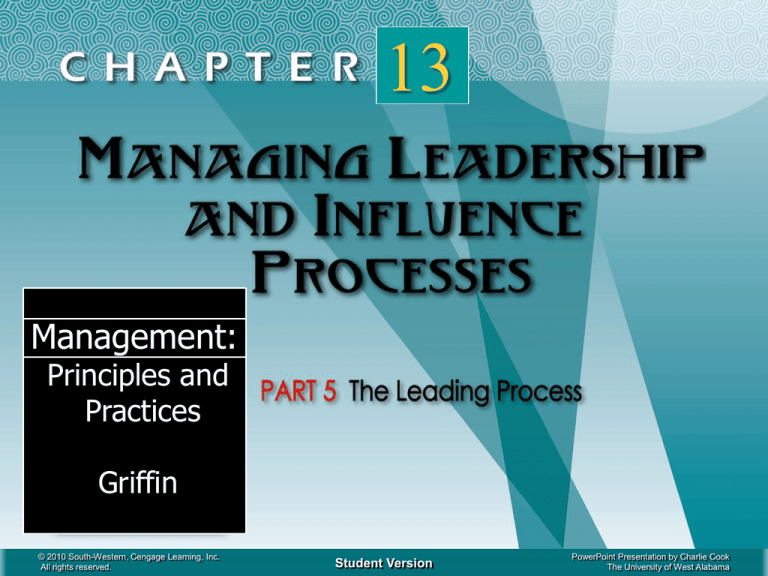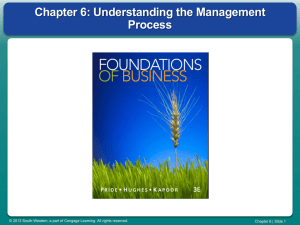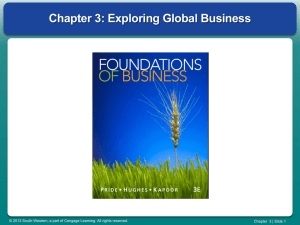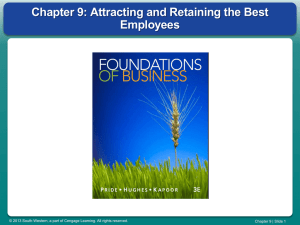
13
Management:
Principles and
Practices
Griffin
© 2010 South-Western, Cengage Learning, Inc.
All rights reserved.
Student Version
PowerPoint Presentation by Charlie Cook
The University of West Alabama
The Nature of Leadership
• The Meaning of Leadership
Leadership as a Process: what leaders actually do.
Using noncoercive influence to shape the group’s or
organization’s goals.
Motivating others’ behavior toward goals.
Helping to define organizational culture.
Leaders are people who can influence the behaviors of
others without having to rely on force.
Leadership as a Property: who leaders are.
Characteristics attributed to individuals perceived as leaders.
Leaders are people who are accepted as leaders by others.
© 2010 South-Western, Cengage Learning, Inc. All rights reserved.
13–2
The Nature of Leadership (cont’d)
Legitimate power
Reward power
Types of
Power
Referent power
© 2010 South-Western, Cengage Learning, Inc. All rights reserved.
Coercive power
Expert power
13–3
Power and Leadership
Legitimate
request
Instrumental
compliance
Coercion
Uses of
Power by
Leaders
Rational
persuasion
Inspirational
appeal
© 2010 South-Western, Cengage Learning, Inc. All rights reserved.
Personal
identification
Information
distortion
13–4
Generic Approaches to Leadership
• Leadership Traits Approach
Assumed that a basic set of personal traits that
differentiated leaders from nonleaders could be used
to identify leaders and as a tool for predicting who
would become leaders.
The trait approach did not establish empirical
relationships between traits and persons regarded as
leaders.
© 2010 South-Western, Cengage Learning, Inc. All rights reserved.
13–5
Approaches to Leadership
Leadership Behaviors Studies
Michigan Studies
Job-centered
behavior
Employee-centered
behavior
© 2010 South-Western, Cengage Learning, Inc. All rights reserved.
Ohio State Studies
Initiating-structure
behavior
Consideration
behavior
13–6
Situational Approaches to Leadership
• Situational Models of Leader Behavior
Assume that:
Appropriate leader behavior depends on the situation.
Situational factors that determine appropriate leader behavior
can be identified.
• Situational Leadership Theories:
Leadership behavior continuum
Least preferred coworker theory
Path-goal theory
Decision tree approach
Leader-member exchange approach
© 2010 South-Western, Cengage Learning, Inc. All rights reserved.
13–7
Related Approaches to Leadership
• Substitutes for Leadership
A concept that identifies situations in which leader
behavior is neutralized or replaced by characteristics
of subordinates, the task, and the organization.
Characteristics that Substitute for Leadership
Subordinates
Task
Organization
Ability
Experience
Need for independence
Professional orientation
Indifference towards
organizational goals
Routineness
The availability of feedback
Intrinsic satisfaction
Formalization
Group cohesion
Inflexibility
A rigid reward structure
© 2010 South-Western, Cengage Learning, Inc. All rights reserved.
13–8
Related Approaches… (cont’d)
• Charismatic Leadership
• Transformational Leadership
© 2010 South-Western, Cengage Learning, Inc. All rights reserved.
13–9
Keys to Successful Leadership
Trusting in
subordinate
s
Keeping
cool
Developing
a vision
Successful
Leadership
Encouraging
risk
Inviting
dissent
© 2010 South-Western, Cengage Learning, Inc. All rights reserved.
Being
an expert
Simplifying
things
13–10
The Future of Leadership
Strategic
Leadership
Cross-Cultural
Leadership
Emerging Approaches
to Leadership
Ethical
Leadership
© 2010 South-Western, Cengage Learning, Inc. All rights reserved.
13–11
Political Behavior in Organizations
• Political Behavior
The activities carried out for the specific purpose of acquiring,
developing, and using power and other resources to obtain one’s
preferred outcomes.
Inducement
Persuasion
Common Political
Behaviors
Coercion
© 2010 South-Western, Cengage Learning, Inc. All rights reserved.
Creation of an
obligation
Impression
management
13–12
Key Terms
•
•
•
•
•
•
•
•
•
•
leadership
leaders
power
legitimate power
reward power
coercive power
referent power
expert power
job-centered leader behavior
employee-centered leader
behavior
• initiating-structure behavior
• consideration behavior
• concern for production
© 2010 South-Western, Cengage Learning, Inc. All rights reserved.
• concern for people
• least-preferred coworker (LPC)
measure
• path-goal theory
• Vroom’s decision tree approach
• Leader-member exchange (LMX)
model
• Substitutes for leadership
• charismatic leadership
• charisma
• transformational leadership
• strategic leadership
• political behavior
• impression management
13–13





